tuesday 10 December 2013 at 09h00
A few weeks ago, several websites mentioned the overhaul of professional cycling based on a project presented by the UCI at the occasion of the World Championships in Florence last September. These websites then mentioned cicloweb.it as the source of the document and one could think of a leak but ... that was not at all the case!
Now the project has been presented in the different regulating bodies of cycling in the different countries, velowire.com would like to have a critical look at the project ...
The source of the official document about the renovation
As indicated above, several websites mentioned cicloweb.it as the source of the official document which presented the main elements of the renovation of professional cycling. The Italian website indeed published an article on 30 October presenting the project, but this was not -as one could think reading what other website wrote- an unexplained leak but simply the result of the journalist who wrote this article being an alert observer. Indeed, he probably keeps an eye on the publications on the website of the Lega del Ciclismo Professionistico, or the Italian Professional Cycling League, since an official article on this website, probably following a presentation of the project during a meeting of the instance which represents professional cycling in Italy, was the first to make the document public!So there was no leak, but an official publication which led to a bit of buzz but not that much discussion. Indeed, for the first time, the document arrived in the hands of the public even though often it had not yet been presented in the managing bodies of cycling in other countries. For example, in France the project was presented only in the second half of November!
The author of the article on the website of the Italian Ligue doesn't really judge the project, he simply concludes the article saying that the contents of this renovation mean to profoundly modify the structure but also the traditions of cycling (!) and that nothing will ever be as before. The article ends with the conclusion that the debate will soon be open on the question whether this is a positive or a negative change and the author hopes that for the cycling sport and mainly also for the fans (who are pretty much forgotten in UCI's analysis) it will be a positive change ... I'm not so sure about that!
The origin of the renovation
The renovation as presented in this document follows the first analyses realised between November 2011 and March 2012 and which resulted in the definition of a common ground, the main topics on which the consulted parties agreed at that time.Several meetings took place starting there (including one based on the study realised by the Institut des Sciences du Sport de l'Université de Lausanne [ISSUL]) which conclusions were consolidated in a meeting of the stakeholders of cycling in Naples on 2 May 2013. The result of this meeting was a framework agreement about the renovation.
In parallel, Deloitte, often solicited by the UCI, set up -on behalve of the UCI- a consultation of the stakeholders of cycling, riders, teams, race organisers, sponsors, sports institutions, media and fans. This consultation, with the title "A Bright Future for Cycling" should cover 4 main items: globalisation, doping, the riders and the race calendar. It took place early this year and mainly in March, with specific consultations of riders the day before Paris-Nice and the day before Tirreno-Adriatico (in which only about 12 riders participated for each of the sessions) and an online survey, freely accessible, which could be filled in by whoever wanted to fill it in between 21 February and 15 March.
Based on these consultations, of which the online survey generated 6,369 answers including 5,638 from the "general public" coming from 73 countries, Deloitte compiled an impressive 103 pages report.
Concerning the cycling calendar, the report insisted on the conclusion that the UCI WorldTour races must be the "best races" with the "best riders".
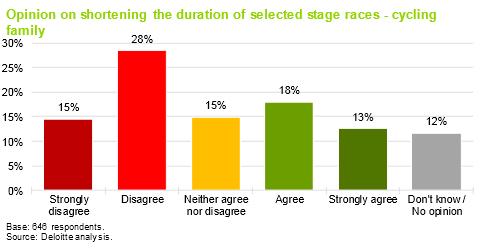 Looking a little bit more in detail one quickly realises that the majority which said this represents only 51% of the respondents of the general public (and is thus only a very small majority). Furthermore, the points system (individual and per team) seems to be understood by only 30% of the public which -as a result- doesn't understand the sportive value which is one of the main criteria in the selection procedure of the UCI ProTeams (infographic).
Looking a little bit more in detail one quickly realises that the majority which said this represents only 51% of the respondents of the general public (and is thus only a very small majority). Furthermore, the points system (individual and per team) seems to be understood by only 30% of the public which -as a result- doesn't understand the sportive value which is one of the main criteria in the selection procedure of the UCI ProTeams (infographic).Concerning the feedback from the cycling family (the representatives of the actors of the cycling sport), 31% of them indicated that they would like to see the length of certain stage races reduced in order to allow the calendar to develop further (see illustration on the right; and recently the organiser of the Tour of Spain seemed to indicate he would accept his race to be shorter under the condition that the best cyclists participate*; as a reminder, the Vuelta a España is now fully owned by ASO).
* we'll see further in this article why this condition is not without consequences
Looking at the opinion of the general public about the races other than those of the UCI WorldTour, the races of the continental calendars, we realise that the public well understood that these races are the base for the development of the cycling sport (the differences between the different continents is explained by the over representation of European and American respondents rather than a different level of appreciation):
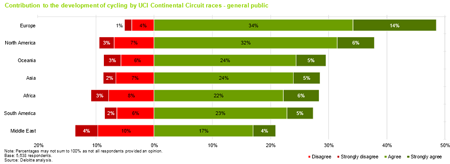
>> If you would like to read it in full, you can download the Deloitte report on the "UCI Stakeholder Consultation: 'A Bright Future for Cycling'"
The renovation project for the international calendar
Let's now get back to the renovation project for the international cycling calendar. Let's try to get a better idea based on the presentation document which was used during the World Championships in Italy in September this year.The document's title is La réforme du cyclisme professionnel 2015-2020 (The renovation of professional cycling 2015-2020). First of all, I must mention that since the original presentation, it has already been decided to postpone the start of this renovation to at least 2017 (where the document announced the writing of the new rules on 15 January 2014 for a progressive renovation starting in 2015 and finishing completely in 2020).
After having presented the important dates in the creation process of this project, the document contains a page which lists the people behind it, called the stakeholders of cycling by the document. It's easy to see that the UCI WorldTour was over-represented compared to races from the lower levels. Indeed, the race organisers which were present (in brackets I only mentioned the UCI WorldTour races organised by these organisers) we found ASO (Paris-Nice, Paris-Roubaix, La Flèche Wallonne, Liège-Bastogne-Liège, the Critérium du Dauphiné and the Tour de France), RCS (Tirreno-Adriatico, Milan-Sanremo, the Giro d'Italia and the Tour of Lombardy), the Grands Prix Cyclistes in Canada (Québec and Montréal), Flanders Classics (Gand-Wevelgem and Tour of Flanders), the Tour de Romandie and GCP (Tour of Beijing).
Furthermore, the AIOCC (Association Internationale des Organisateurs de Courses Cyclistes) was present but we all know that the big race organisers in the UCI WorldTour play an important role in this association and especially ASO which is represented by Christian Prudhomme as the president of the AIOCC, Thierry Gouvenou as the general adjunct secretary and Jean-François Pescheux as the general secretary. Pescheux was the AIOCC representative in the working group around the calendar.
The UCI WorldTour itself was also represented, by Charly Mottet, who also works in the Grands Prix Cyclistes in Canada.
The teams and riders were represented as well:
- the teams with 3 representatives of the Association Internationale des Groupes Cyclistes Professionnels (AIGCP), from the Movistar and Argos-Shimano teams as well as the director of the association (Luuc Eisenga, former Rabobank team staff member)
- the riders via 2 representatives of the CPA (Cyclistes Professionnels Associés) and Bernhard Eisel who represented the Athletes Commission of the UCI
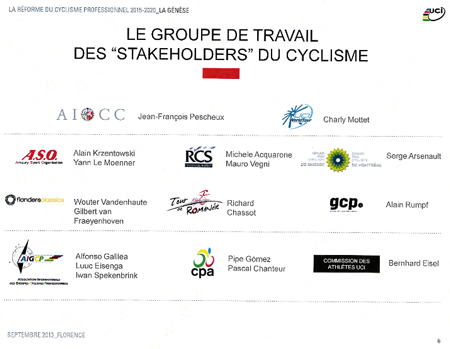
CONTINUE READING AFTER THIS ADVERTISEMENT
The action areas for the renovation project
The document then presents the 5 action areas which were validated upfront for this renovation project:1/ reduce the number of races at the highest level
2/ identify ways to develop new events
3/ modify the selection process of the teams
4/ professionalise the structure of the teams
5/ reorganise the UCI WorldTour calendar with 2 or 3 levels
The contents of the renovation
Concerning the contents of the renovation, the document starts with the introduction of a new notion, invented by the Institut des Sciences du Sport de l'Université de Lausanne (ISSUL), which is called ERP for exigence règlementaire de production. The only definition given for the ERP is the ratio which determines the production percentage of the teams linked to first and second division races (knowing that so far the document had never mentioned first and second division races yet).This ratio would take into account 3 fixed values (22 riders per team, 120 racing days in the calendar of first division races and the number of racing days per rider which doesn't seem to be defined yet) and 7 variable values (number of first division teams and number of second division teams [which, even though they're defined to be variable, are fixed at respectively 16 and 8 further on in the document], number of racing days in the second division calender [fixed at 50 days further in the document], number of wildcards in the first division races, number of participating teams in the races, percentage of first division teams allowed in second division races [75% further in the document] and the size of the teams in the races [7, 8 or 9 riders]). We won't get any further information about the exact calculation based on these values though, nor on what exactly means the rules saying that the Exigence Règlementaire de Production cannot be more than 84% for the first and second division races ...
The calendar
With this we thus learned that there will be first and second division races. Like it's the case today you might say, with the UCI WorldTour on one side and the races of the continental calendars on the other (with different levels even for the latter races). But in this case, the two divisions concern the UCI WorldTour races:- 1st division: 120 racing days
- 3 Grands Tours: 63 days (Giro d'Italia, Tour de France and Vuelta a España; so what about the reduced duration proposed by the director of the Vuelta?)
- stage races in Europe: 24 days (Paris-Nice, Tirreno-Adriatico, Critérium du Dauphiné and Tour of Switzerland)
- one day races: 12 days (Milano-Sanremo, Gand-Wevelgem, Tour of Flanders, Paris-Roubaix, Amstel Gold Race, Flèche Wallonne, Liège-Bastogne-Liège, Clasica Ciclista San Sebastian, Vattenfall Cyclassics, Grand Prix Cycliste de Québec, Grand Prix Cycliste de Montréal and Tour of Lombardy)
- new races: 11 days
- stage races outside Europe: 10 days (Tour Down Under and Tour of Beijing) - 2nd division: 50 racing days
(Dubai Tour [RCS], Tour of Qatar [ASO], Tour of Oman [ASO], Omloop Het Nieuwsblad [Flanders Classics], Grand Prix E3, Dwars door Vlaanderen [Flanders Classics], Tour of the Bask Country/Vuelta al Pais Vasco, Flèche Brabançonne/De Brabantse Pijl [Flanders Classics], Tour de Romandie, Bayern Rundfahrt [Bayern Rundfahrt e.V.], Tour de Pologne, Eneco Tour, Grand Prix de Plouay, Paris-Tours [ASO])
=> in bold the races which are currently on a continental calendar and which would thus be promoted to the second division of the UCI WorldTour. All these races, except for the Dubai Tour, organised for the first time in 2014, are currently hors catégorie (highest level in the continental calendars). Except for the Bayern Rundfahrt we see that all these races are organised by ASO, RCS or Flanders Classics, all present in the working group.
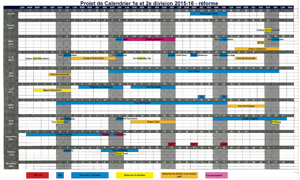
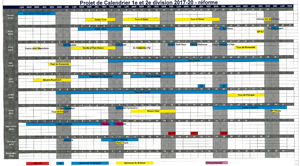
It is thus clear that all races have already been filled in in the calendar, despite the fact that the document presents the selection process for the races which would be based on 3 criteria:
- the organisation principles of the calendar
the season will take place from February till October, every weekend and mainly on Sunday, no overlaps between races, no competition between 1st and 2nd division races, 6 uninterrupted weeks of competition for the spring classics and stage races reduced to 5 or 6 days - the requirements to fulfill
efficient logistics, good quality hotels, high quality organisation, necessary security measures, a high level TV production and world wide TV broadcast, many spectators - the financial capability
capacity too assume the cost of the measures related to the requirements to fulfill, raise of license taxes, raise of travel reimbursements of the teams
The reorganisation of the teams
In order to make the renovation complete, the calendar working group also imagined a new organisation of the professional teams. Instead of having 23 to 30 riders (23 being the minimum 30 being the maximum number of riders of a UCI ProTeam, the latter being possible if a team has at least 2 neo-pros, cf. article 2.15.110 of the UCI rules), the first division teams would be obliged to create a team A of 22 riders and a team B of 8 to 10 riders, called the development team. There should be 16 first division teams with such a structure.In addition to those teams there would be 8 second division teams and 3rd division teams (the current pro continental and continental teams).
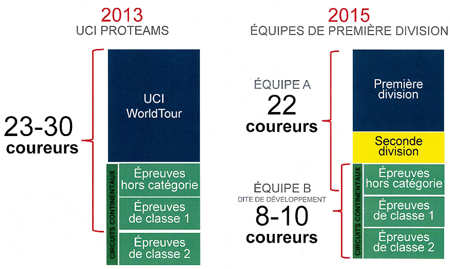
The selection of teams would be based on almost the same criteria as currently is the case (see the selection procedure of the UCI ProTeams (infographic)): the criteria sports value, now with a real automatic promotion/relegation system, ethical, base on recommendations from the ISSUL, financial, still based on an audit by Ernst&Young, and administrative, based on an audit by Ernst&Young and by the administration of the UCI.
CONTINUE READING AFTER THIS ADVERTISEMENT
The participation rules
When we mix all that, calendar, reorganisation of the teams, divisions, and so on, there's only one thing missing: participation rules which define who participates in which race and in which division or calendar. And, maybe even more than the changes to the calendar which seems mainly based on the participants in the working group, this seems to be the most problematic point ...I'll first let you discover the participation rules for yourself in the images below:
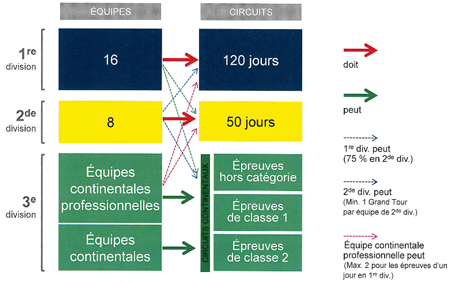
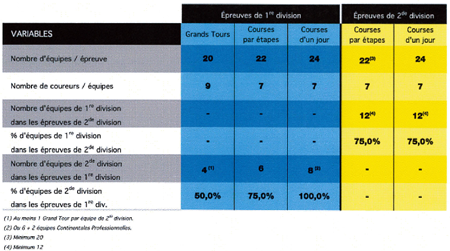
Listing the teams like this we realise that the race will lose a big part of its peloton which attracts the public and the race will thus probably have more difficulties in finding sponsors and staying at this level. Little by little this could thus make races like these disappear and that ... could be the start of the end of the cycling sport as we know it as Guillaume Di Grazia (Eurosport) confirmed in front of our camera:
(>> you can see the rest of the interview in the article Flashback on the award ceremony of the Coupe de France 2013)
According to the latest news, the participation in class 1 races would finally also be possible for 1st and 2nd division teams from the country in which the race takes place but that doesn't really remove the problem (the two races mentioned above would still lose respectively 3 and 10 top level teams).
As I mentioned in the interview with Guillaume Di Grazia above, this evolution attacks cycling in one of the lower layers of the pyramid which forms the international cycling sport. Indeed, in races like these the young professional riders can try themselves against big names of international cycling and if they will no longer be able to participate in these races this will create a hole in the progression of young riders and, as mentioned above, this could also lead to races to disappear, which would mean that it really announces the start of the end of international cycling ...
All this comes out in a context where the UCI survey clearly indicated that the races on the continental calendars are useful. Indeed, over 48% of the respondents who answered this question think for example that the UCI Europe Tour contributes to the development of cycling. The respondents above all appreciate the organisation in different "levels" of the cycling sport and thus the progression which continental races make possible.
44% of the general public wasn't able to answer this question, which in my opinion doesn't show they would think these races useless but more that the calendars are not enough well known and that each individual race is thus better known than the collection of races in one of the calendars. For example, when a sponsor in cycling recently asked me to provide him with "the top 100 of international cyclists", I had to complete my answer with an explanation of the fact that the only official classification which I could provide him with is not necessarily representative since it only concerns the UCI WorldTour races, providing him at the same time a more complete but not official classification provided by cqranking.com ... (one of the rare points this project seems to tackle since, in addition to the classifications of the 1st, 2nd and 3rd division [Europe Tour, America Tour, Asia Tour, Africa Tour and Oceania Tour], a global classification would be established based on all international races).
And you, what do you think of this project??
You have just discovered the renovation project for international cycling and the impacts it might have on the sport itself. Now it's your turn to tell what you think! Do you think this is a good idea? Or is it a bad idea as a whole? Or would you rather say that there are some good points to keep and others to get rid off as soon as possible? Please share your thoughts in a comment below! door Thomas VergouwenVond u dit artikel interessant? Laat het uw vrienden op Facebook weten door op de buttons hieronder te klikken!
4 comments | 37248 views
this publication is published in: UCI ProTour | Cycling general (except Tour de France)





 by dedou04 over
by dedou04 over
Cette réforme de l'UCI ET des organisateurs d'épreuves WT (ASO, RCS, Flanders Classics, etc ..) met bien évidemment en péril toutes de course de classe 1 en empêchant aux 24 meilleurs équipes d'y participer.
Ce qui me rassure, c'est que cette réforme (a peine pondue) est déjà repoussée à 2017 au lieu de 2015, il y a donc bcp de temps pour la modifier.
ASO, RCS, Flanders Classics... Reste à savoir qui joue Roosevelt, qui joue Churchill et qui joue Staline. Ce qui m'embête un peu, c'est que certains patrons des puissantes équipes Pro Teams qui soutiennent cette réforme (Lefevere par exemple) approcheront l'âge de la retraite en 2020 et pensent partir avec un bon profit en laissant un champ de ruines. Avec la menace qui pèse sur les classe 1, dans quelles épreuves formera-t-on les jeunes coureurs ? L'exigence de rigueur sur le cahier des charges me semble en revanche recevable. Enfin, je vois "qu'un public nombreux" figure dans les critères pour prétendre recevoir le label "Première division" sur certaines courses. Je constate que le Tour du Qatar figurera dans ce calendrier, ce qui me fait donc doucement rigoler au regard de la foule en délire qui se presse généralement sur les aires d'arrivées. Mais bon. D'ici là, le Qatar aura donc le temps de s'acheter des spectateurs...
J'espère que ce projet UCI n'est qu'un brouillon !!!
L'idée de refonder les 3 divisions n'est pas, pour moi, la meilleure solution, il n'y a pas que 24 équipes en World Tour et en Continentale Pro, et le nombre d'équipes qui ont pu participer au World Tour cette année s'élèverait peut-être à 35 !!! Qu'adviendra-t-il des petites équipes qui attendent un "instant de gloire" (une échappée sur une WT) pour conserver un sponsor ?
Le monde du cyclisme va se refermer sur lui-même où nous aurons droit qu'à des petites équipes formatrices qui courront qu'entre elles et à la fin des structures moyennes qui peuvent parfois peser !
Et là, nous avons une sacré hypocrisie, puisqu'aucun (ou presque) organisateur des courses d'un jour iront chercher des équipes de 3e division.
Quant au calendrier : on conserve le tour de Beijing à l'autre bout du monde dans le premier chapeau et on relègue des grandes épreuves comme le tour du Pays-Basque, le tour de Pologne et le tour de Romandie (à s'assied sur l'histoire cette fois !), pour les mettre au même niveau que les épreuves du Moyen Orient et du tour de Bavière !!! (il y a un bavarois dans l'entourage du nouveau président de l'UCI ? puisque sa place est vraiment incompréhensible).
Et des épreuves comme le Kuurne (merci de le souligner Thomas) sans une grosse participation, je ne l'avais jamais imaginé.
L'argent ne fait pas tout et des épreuves en plein désert ne pourront jamais accueillir des supporters (forcément !), et personne ne les regardera à la télé non plus (décalage horaire oblige). Si l'internationalisation du sport passe par la dégradation de grandes épreuves au profit de celles qui n'intéressent pas forcément, il faudrait peut-être revoir sa copie.
Autre problème : la médiatisation sera également moindre par de nombreuses équipes, des sponsors de certaines équipes (même WT pour 2014) prolongeraient-ils en cas de non-retour sur investissement ?
Bonjour à tous,
J'ai essayé de réfléchir à une nouvelle organisation du cyclisme professionnel, et force est de constater que c'est un exercice difficile, où on est sans cesse tiraillés entre modernisme et tradition.
Voici le résultat que j'ai obtenu.
1.Divisions
Comme actuellement, les équipes seront décomposées en 3 division. La 1ère division, nommée, Champions Team (pour se rapprocher la Champions league de football, dont le nom est connu), sera composée de 24 équipes, chacune composée de 20 à 25 coureurs. Je suis parti sur ce nombre élevé car ceci permet d'inclure toutes les grandes équipes et toutes celles qui à l'heure actuel font des demandes de wild card (on est même plus large avec la présence de Wanty), de plus on se retrouverai cette année avec des équipes des 5 continents (voir graphique ci dessous).
La seconde division nommée "Continental League", regroupe les 12 équipes suivantes, composées de 15 à 20 coureurs.
Enfin la dernière division regroupe toutes les autres équipes (5 à 10 coureurs).
Mode de sélection des équipes :
En fin d'année, 2 classements sont effectués. Un classement prenant en compte les résultats de l'année en cours (2013), en additionnant les points de tous les coureurs de l'équipe, et un classement de l'année suivante(2014), en prenant en compte les transferts.
Les 24 premières équipes de 2013 sont qualifiées automatiquement en Champions league.
Si dans les 24 équipes, certaines s'arrêtent, on prend le classement 2014, et on complète la liste de 24 avec les meilleurs équipes 2014 n'étant pas dans les 24 premières de 2013. Ceci permet d'inclure de nouvelles équipes avec de grand coureurs, sans désavantager les équipes ayant fait une bonne saison 2013.
Les équipes classées entre 24 et 36 en 2013 et non repêchées en champions league sont qualifiées en continental League.
Si dans les 12 équipes, certaines s'arrêtent ou sont qualifiées en champions league grâce à leur classement 2014, on prend le classement 2014, et on complète la liste avec les meilleurs équipes 2014 n'étant pas déjà qualifiées.
Voici ce que cela donnerait pour l'année 2014, en se basant sur le classement cqranking :
[img]http://image.noelshack.com/fichiers/2014/03/1389985767-divisions.png[/img]
2.Classification des compétitions
Les épreuves sont décomposées en 4 groupes :
Les épreuves de Champions league : Les 24 champions teams sont automatiquement qualifiées. Une 25éme équipe est invitée. Cette équipe doit obligatoirement être une Continental Team. Toutes les compétions voient 25 équipes au départ. Elles seront composées de 5 coureurs pour les courses par étape, 6 pour les courses d'un jour.
Epreuve League 1: C'est un peu l'équivalent des course Hors catégories. Ces compétitions peuvent accepter au maximum 16 équipes de Champions league et 6 de Continental team. Il doit y avoir obligatoirement 22 équipes au départ (à moins que l'organisateur ait reçu moins de demandes). Le peloton est complété avec des équipes nationales.
Epreuves de league 2 : Equivalent des épreuves 2.1 et 1.1. Le peloton doit être composé au maximum de 50% d'équipes de Champions league, 30% d'équipe Continental League et plus de 20% d'équipes nationales.
Epreuves de league 3 : Equivalent des épreuves 2.2 et 1.2. Le peloton doit être composé au maximum de 10% d'équipes de Champions league, 30% d'équipe Continental League et plus de 60% d'équipes nationales.
[img]http://image.noelshack.com/fichiers/2014/03/1389985768-epreuves.png[/img]
1.Barème et classements
Un classement individuel, regroupant tous les cyclistes professionnels.
Un classement par équipe avec les équipes de toutes les divisions.
Le barème de points est complètement différent de l'actuel. En Champions league, beaucoup plus de coureurs marquent des points.
Les équipiers du vainqueur remportent également des points (pour le travail effectué)
Sur les courses par étapes, les vainqueurs du classement de la montagne et du classement par point marquent des points.
De même, tous les soirs, les porteurs des 3 maillots majeurs glanent également des points.
Enfin, un point particulier, tous les coureurs dans le même temps que le dernier coureur marquant des points remportent le même nombre de points. Par exemple, sur Paris Roubaix, si le 26ème arrive dans le même temps que le 25ème, il marque également 16pts.
En cas de cas de dopage, un coureur perd tous ses points, son équipe perd également 50pts supplémentaires au 1er cas, 100 au 2ème et 150 pour les suivants (nombre de cas dans une saison).
Détail du barème :
[img]http://image.noelshack.com/fichiers/2014/03/1389985766-baremes.png[/img]
3.Le calendrier Champions League
Ce calendrier se veut international, avec des étapes sur les 5 continents. L'exemple ci dessous se base sur le calendrier 2015.
La saison internationale s'étale de mi Janvier à mi Novembre. Aucun jour de course ne se superpose, excepté le Tour de Pologne, dont une étape se déroulera le jour du Grand Prix de Québec, et l'arrivée le jour du départ de la course par étape américaine. La superposition est atténuée par le fait qu'avec le décalage horaire, les courses ne se dérouleront pas en même temps.
Le mois de Janvier reste proche de ce qui existe déjà. Les 2 courses proposées ont lieu en Australie, avec une course d'un jour (course en ligne se terminant par le circuit du critérium précédant le Tour Down Under) et le Tour Down Under.
Février propose un schéma similaire à l'Australie (course d'un jour + course par étape), mais en Afrique, j'ai positionné la course d'un jour en Afrique du Sud, et utilisé pour la course par étape la Tropicale Anissa Bongo, plus grande course Africaine actuelle. La suite du mois se déroule en Amérique du Sud, avec une cassique reprenant le circuit des moniaux de 1995 en Colombie, puis direction l'Argenine pour disputer le Tour de San Luis.
En Mars, retour en Europe avec un gros bloc de courses, par étapes. Paris Nice est avancé d'une semaine, commence un Samedi et se termine un Samedi, pour ne pas se supersposer avec Tirreno Adriatico, qui est avancée de 3 jours. Le Tour de Catalogne débute dès le lendemain de l'arrivée de Tirreno. Commence alors les grandes classiques du calendrier, avec la Primaverra pour commencer, puis GP E3 en semaine et Tour des Flandres, avancé d'une semaine. Le Tour du Pays Basque conserve sa place entre La Ronde et Paris Roubaix.
Avril débute avec la fin du Tour du Pays Basque On continue avec Paris Roubaix, et Gand Wevelgem pour terminer les Flandriennes. On enchaine comme cette année avec l'Amstel, La Flèche et Liège. Grande nouveauté, le Tour d'Espagne retrouve sa place en Avril. La course est ramenée à 2 semaines et 15 étapes. Si je ne suis perssonnelement contre la éduction des 3 grands Tours, j'ai opté pour cette option après les paroles du directeur de la Vuelta, près à réduire la durée de son épreuve.
En Mai, fin de la Vuelta, et 5 jours plus tard, départ d'un Giro démarrant une semaine plus tard.Ceci permettra peut être de réduire les risques de mauvaises conditions météorologiques.
En Juin, fin du Giro, et le week end suivant, création d'une nouvelle épreuve dans les Alpes, avec une compétition sur 3 jours se déroulant chaque année dans un pays différent de l'arc Alpin. L'objectif est de proposer de mi Mai à mi Aout des compétitions en montagne. Je suis parti sur 3 étapes comme suit : un CLM en côte, une étape marthon(250km – 6500m de dénivellé positif minimum), et une étape très courte pour terminer(moins de 150km mais 3500m de dénivellé minimum). Mon autre idée serait de proposer 3 courses d'un jour en montagne se déroulant le Mercredi, Vendredi et Dimanche. Il manque en effet des classiques en montagne. Juin continue avec les championnats nationaux (CLM le Jeudi, course en ligne le Dimanche), la classique de Hambourg avancée de 2 mois et disputée en semaine, et se termine par le départ du Dauphiné, beaucoup plus tard qu'actuellement. Le départ du Dauphiné est donné un Samedi, pour conserver 8 jours de courses et ne pas se chavaucher avec le Tour de S uisse.
En Juillet, fin du Dauphiné, un Samedi à seulement 2 semaines du départ du Tour. Le lendemain, départ du Tour de Suisse, qui se terminera seulement 5 jours avant le départ du Tour. Le Tour de France débute 2 semaines plus tard qu'en 2014, avec un départ le 1er Samedi de la 2ème quinzaine de Juillet.
Aout commence avec la fin du Tour, et s'enchaine avec le Tour de Romandie, décalé en Aout pour proposer un parcours plus difficile, avec une météo qui devrait être plus avantageuse. La course devrait réunir tous les grands noms n'ayant pas participé au Tour de france. On enchaine avec la Classica St Sebastien, en semaine, à quelques jours des mondiaux, qui retrouvent leur place fin Aout.
Ces mondiaux seraient composés uniquement de course disputées par équipe natiaonales. Le CLM par équipe est supprimé. Le programme serait :
Samedi : Compétion par équipe féminine. 1 Junior et 2 seniors se relaient sur le circuit des mondiaux. Chacune fait 3 tours de circuit, en passant le relais à la fin de chaque tour.
Dimanche : Compétition par équipe masculine : 1 juinor, 2 espoirs et 4 élites se relaient sur le circuit des mondiaux. Chacune fait 3 tours de circuit, en passant le relais à la fin de chaque tour.
Lundi : CLM individuel junior femmes et espoir hommes.
Mardi ; CLM individuel junior hommes et élite femmes.
Mercredi : CLM individuel élite hommes.
Jeudi : Jour de repos.
Vendredi : Course en ligne junior femmes et espoir hommes.
Samedi : Course en ligne junior hommes et élite femmes.
Dimanche : Course en ligne élite hommes.
En Septembre, c'est la tournée Américaine, avec les 2 classiques canadiennes à Québec et Montréal, et une compétition de 2 semaines et 15 étapes aux Etats Unis, que j'ai situé autours de la Sierra Nevada. Les coureurs restés en Europe pourront profiter du Tour de Pologne pour conserver lur forme.
En Octobre, ce sera la tournée Asiatique, avec le Tour de Pekin, 2 courses d'un jour au Japon, et le Tour de Langkawi, déplacé de Février à Octobre.
Enfin, en Novembre, retour en Europe, pour un Tour du Bénélux plus tourné vers l'esprit des classiques de Primptemps, puisque le temps sera plus frais qu'en Aout.Le Tour de Lombardie retrouve une place très, et les feuilles mortes devraient être au rendez vous. Enfin, la saison se termine en Afrique, au Tour du Rwanda. J'ai rajouté cette épreuve après avoir vu des images de la foule au bord de la route, c'était impressionnant, il y a un vrai potentiel de course populaire là bas, pas comme en Chine.
[img]http://image.noelshack.com/fichiers/2014/03/1389985769-calendrier.png[/img]